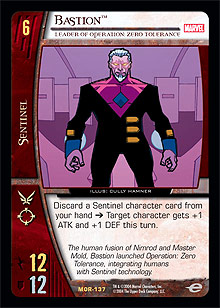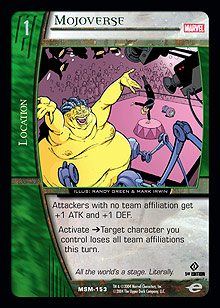Every deck starts as a rogue deck. That cursed netdeck of tomorrow—the one that shows up at every tournament and dominates the Top 8—was at some point just a glimmer in some deckbuilder’s eye. Before the no-hand Squadron decks took over in Golden and Modern Age and won a Pro Circuit, someone was looking at a Squadron Supreme team that appeared to be utterly awful and started asking themselves, “How can I make this work?” Even if that player doesn’t find the optimal build, the deck can take off and become the scourge of a format.
But sometimes, even those ideas need a little help. Occasionally, a deck just doesn’t have the cards it needs to get to those low-numbered tables; a particular drop may need to be shored up, or the deck may need a plot twist that addresses some particular weakness. Sometimes that very card will come along and vault your rogue deck from the bottom of the heap to the top of the mountain.
Let’s take a look at an example.
Curve Sentinels
Dave Spears
 2nd Place, $10K Texas
2nd Place, $10K Texas
Characters
4 Boliver Trask
6 Sentinel Mark III
7 Sentinel Mark II
6 Sentinel Mark V
4 Nimrod
2 Master Mold
4 Bastion
3 Tri-Sentinel
Plot Twists
4 Cover Fire
4 Tag Team
4 Reconstruction Program
3 Finishing Move
3 Savage Beatdown
Locations
3 South American Sentinel Base
3 Underground Sentinel Base
I know that a lot of people think of Curve Sentinels as the antithesis of rogue deckbuilding. The deck took control of Golden Age for a solid year, from PC: L.A. 2004 through PC: L.A. 2005. It survived PC: New York, where everyone knew that it was Public Enemy #1, and it still put six players into the Top 8. It survived the banning of Overload, a card that Curve Sentinels could take advantage of better than any other deck. It took a year and the release of The Avengers for the dominance of Curve Sentinels to finally come to a close.
But as I said above, every deck starts as a rogue deck, and Curve Sentinels was no different. At the first Pro Circuit, I played against Patrick Yapjoco, a formidable rogue deckbuilder, in a tournament on Sunday. To the winner went a copy of the Fantastic Four #5 comic book, the first book to feature Dr. Doom. I was 4-1, as was Patrick, and I was playing Titans. Patrick was playing Curve Sentinels. Let me emphasize that this was after the first Pro Circuit, which was before the release of Web of Spider-Man and therefore before the release of Sentinel Mark V. Patrick was running the decidedly undersized Sentinel Mark IV instead. I lost the match in two games, mostly due to timely Search and Destroys for important power-ups in both games. The match put Patrick into the Top 8 and me out of it.
Out of that deck came this deck, with some timely legacy additions. Once Web of Spider-Man was released, Sentinel Mark III, Sentinel Mark V, Tag Team, and Tri-Sentinel all joined the Sentinel army, and Patrick was able to take the deck from a cute rogue deck to a powerhouse.
Sentinel Mark III did one important thing for Curve Sentinels: it allowed Sentinel Mark II to attack and stun the average 3-drop. Curve Sentinels has weak early characters, but all the Mark II needed was a tiny boost in order to make it up to adequate. Since Curve Sentinels preferred the odd initiatives, an ATK boost on turn 3 allowed it to keep the board relatively even while waiting for Nimrod and Bastion to arrive.
Sentinel Mark V, though, has turned out to be one of the most influential legacy cards in the history of Vs. System. The actual curve of Curve Sentinels had a few weak spots, but the worst was on turn 4. Sentinel Mark IV was fine if you were playing the Wild Vomit deck I featured a few weeks ago, but if you were playing a curve deck, the older robot was simply undersized. Mark V was the right size, had a relevant ability, and could also play as a 5-drop without a drop in quality for boosting (like Gnaxos, for instance). The biggest hole in the curve was suddenly filled, and that helped Curve Sentinels get to turn 6, where Bastion could simply take over a game.
Tri-Sentinel’s mechanical heart was in the right place, but it turned out to be simply outclassed. This version of the Curve Sentinels deck featured both Tri-Sentinel and Underground Research Base, which just added characters to the board in order to increase the damage Tri-Sentinel could do with its ability. But Underground Research Base got cut in later versions to make space for Savage Beatdown/Nasty Surprise/Overload, and Tri-Sentinel was outdone in advance by Magneto, Master of Magnetism, who many Sentinel players were using by PC: L.A. a month later (led by John “Bam Bam” Rich). With Magneto on the table, Genosha drew four cards, and when you have Bastion on the table, four cards is brutal.
Another Web of Spider-Man card that made the initial cut was Tag Team. This pump allowed the deck more chances to stonewall a turn 6 attack. With Bastion on the table and twelve plot twists that increased DEF either directly or indirectly in Tag Team, Cover Fire, and Reconstruction Program, the chances of a turn 6 attack actually succeeding against the Sentinels were slim. Tag Team was another victim of the brutal efficiency of Savage/Nasty/Overload, which found its way into Curve Sentinels decks relatively quickly and was a fixture by $10K Columbus at the beginning of 2005.
Also in 2005 was the release of the Marvel Knights set, and with it the Hounds of Ahab. The Hounds could, depending on your draw, completely lock the opposing player out of the game. Matches hinged on turn 1 Boliver Trask and turn 2 Hounds of Ahab versus any opponent that missed his or her 1-drop. Nasty Surprise, which had already found its place in the deck to benefit Overload, meant that Curve Sentinels could stun the opposing drop off-initiative, KO it with the Hounds, and then team attack next turn with Boliver and Sentinel Mark II to stun the opposing 3-drop, again KO’ing it with the Hounds. If this happened, the game was essentially over. Failing that, it was sometimes possible to Flying Kick and then Overload your opponent’s turn 2 attack if your deck ran the Kick. Then the Hounds could do their dirty work anyway.
The Hounds turned out to be just as influential as Sentinel Mark V. In addition to Curve Sentinels, Hounds of Ahab found a place in the all-hidden MKKO deck as its main 2-drop in both the Modern Age PC in Amsterdam and the Golden Age $10K in Florida, among other places. The ability to KO multiple characters with what turned out to be very little effort (and without using a plot twist) was one of the most powerful effects the game had seen to that point. Hounds of Ahab became the poster child of the newfangled hidden area, which went on to become a staple of Vs. System just as the Hounds themselves became a staple of Curve Sentinels.
By PC: NY in May of 2005, Curve Sentinels had evolved into the deck everyone knew and loved. Tech had been added in the form of Micro-Sentinels to fight off-curve decks, and Mojoverse had been added to battle the now-common Betrayal, but the deck now had all the elements that made it the quintessential Curve Sentinels deck.
Curve Sentinels
Winner, PC: NY 2005
Adam Bernstein
Characters
 4 Boliver Trask
4 Boliver Trask
3 Hounds of Ahab
7 Sentinel Mark II
8 Sentinel Mark V
4 Nimrod
4 Bastion
4 Magneto, Master of Magnetism
2 Apocalypse
Plot Twists
4 Savage Beatdown
4 Reconstruction Program
4 Micro-Sentinels
3 Overload
4 Nasty Surprise
Locations
3 Genosha
2 Mojoverse
Various versions of this deck dominated tournaments in Vs. System until late 2005, when the speed of the Squadron Supreme and the sheer ATK power of the Avengers finally knocked them from their lofty perch atop the Golden Age metagame.
Curve Sentinels is a great example of what happens when a team gets some legacy love in the newest set. With the right card, such as a Sentinel Mark V or a Hounds of Ahab, a team that previously couldn’t keep pace can take over a metagame.
Everyone has a favorite team. Mine, unfortunately, is the Manhunters, but to each their own. Every time a new set comes around, take a look inside to see if your favorite team got some love. It hasn’t happened yet for the Manhunters, but I’m still holding out hope, and there’s a DC set coming up next. The purple robots eventually got hooked up; the red and blue robots will surely get their due in World’s Finest.
Ahem.
Anyway, take a look at those legacy cards. They shouldn’t just get shuffled to the back of the pack in an eight-player draft and forgotten. Look at the new Quicksilver, Terrigenesis Rebirth, for instance. He’s not much of a Draft card unless you’re trying to design your Draft deck around him, but in Constructed, he lets you attack twice with your 6-drop. That’s a hugely powerful ability if you can use it the right way. Or take Hulk, Joe Fixit. He’s a hard character to reinforce when you’re drafting Marvel Team-Up, but really, how hard is he to reinforce in a Constructed deck? His power means that your opponent will probably have to team attack Hulk with his or her entire board of characters just to get a stun, and he’s utterly brutal if your opponent does end up attacking him. If you played the forgotten legacy card Taskmaster on turn 6, you have not one but two 16 ATK / 16 DEF characters, one of which has an unbelievable off-initiative ability.
These are the cards that you should look for—the ones that you glance over while you’re drafting. There are hidden gems there. Take that Quicksilver or that Hulk and prove that legacy cards deserve some respect.
Curve Sentinels may be the anti-rogue deck, but there are, as always, lessons that a rogue deckbuilder can take away. Hate Curve Sentinels if you must, but always remember that it started out as a germ of an idea in the back of a deckbuilder’s mind. Besides, a format with a deck like Curve Sentinels is a format that’s just waiting to be broken open by a rogue deck with the tools to handle a one-deck format. And who knows . . . maybe you’ll even do it with the Crime Lords.
Or the Manhunters.
Until next time,
Mark Slack
ms243@evansville.edu